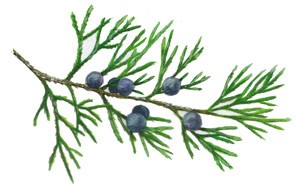
This “cedar,” like most of the many other trees given that name, is not a cedar at all. It’s a juniper. And despite having round, blue fruits that look just like berries and not at all like cones, eastern red cedar is a conifer. The skin of the berry consists of soft scales that have coalesced, so in theory it might properly be called a cone, farfetched as that may seem. The foliage appears in two forms: young leaves stick out and are sharp-pointed and much longer than the other, older kind – tiny, scale-like leaves pressed tightly to the twig.
Tom Wessels, in Reading the Forested Landscape, uses the relative amount of eastern redcedar compared to that of its more northern relative, common juniper (Juniperus communis), to define the northern boundary of southern New England. Southern New England, he says, begins when the mix of these two species is 50-50, and this follows a wavy line across Massachusetts. Farther south, in Connecticut and Rhode Island, the columnar profiles of redcedars far outnumber the low, spreading shapes of common junipers, a shape that is, indeed, very common farther north. Eastern redcedar’s large range extends throughout almost all of the eastern United States and southeastern Canada, but it doesn’t quite make it as far north as northern New England.
In central and southern New England, the eastern redcedars that fill in old fields and line roads and highways look as though they must surely have been planted. The symmetrical, formal, upright, narrowly conical, and tidy trees suggest that a horticulturalist’s dream has come true; but in truth, they are opportunistic native trees, well equipped to invade abandoned fields or wastelands. Far from being fussy nursery stock, they thrive under adverse conditions, in dry, thin, acidic soils.
And it’s birds, not the local nursery, that do the landscaping. Tony Holthuijzen, a biologist who studied cedar waxwings – named for their fondness for eastern redcedar berries – found that it takes 12 minutes for a redcedar seed to pass through the digestive system of a cedar waxwing, and that, after taking that trip, the seed is three times as likely to germinate as one that merely falls to the ground. Waxwings and many other bird species often digest their food while sitting on pasture fences, resulting in redcedar hedgerows that faithfully follow fencelines. If berry-eating birds spend time on high-up telephone lines, the seeds are distributed more randomly.
Cedar waxwings are known for their ability to process fruits, but many other birds join them at the annual fall redcedar berry banquet. Robins, mockingbirds, bluebirds, ruffed grouse, wild turkeys, goldfinches, flickers, and grosbeaks all like the berries, as do a long list of mammals: meadow mice, bears, rabbits, foxes, raccoons, skunks, possums, coyotes, and deer.
In between berry crops, eastern redcedar’s dense evergreen foliage is well used for nesting and cover by wild animals. The branches, especially when the trees are young, go right to the ground, providing a safe refuge. The foliage is not a prized edible for most wildlife species but is used as emergency food. Because cattle dislike the prickly branches, they carefully weed the grasses around redcedar seedlings, allowing the little trees to gain a foothold even before a pasture is abandoned.
Eastern redcedar is a small tree, usually topping out at about 40 or 50 feet, and these days it is mostly used for fence posts as it has good rot resistance. In earlier times, there was a bountiful supply of larger trees and the wood was much more widely used that it is now. Early colonists used it for split rail fences, pails, buckets, tubs, sills, and shipbuilding. Its nearly white sapwood contrasts dramatically with the deep purplish-red heartwood. Sometimes called aromatic cedar, the wood is deliciously fragrant and is used in making chests and closet linings because it repels moths.
The uniform, fine-grained heartwood is among the few woods that cooperate when put into a pencil sharpener and many millions of pencils have been made from eastern redcedar. Only the clearest, knot-free sections of heartwood are suitable for pencils, and most of the wood that heads off to a pencil factory is wasted. The supply of eastern redcedar was much diminished by the 1940s, and now most pencils are made from incense-cedar, a western species.
For a pioneer species, this tree is long-lived and can persist for 200 to 300 years, outliving its hardwood compatriots, especially on poor sites where it may be better at appropriating nutrients and water.


Discussion *